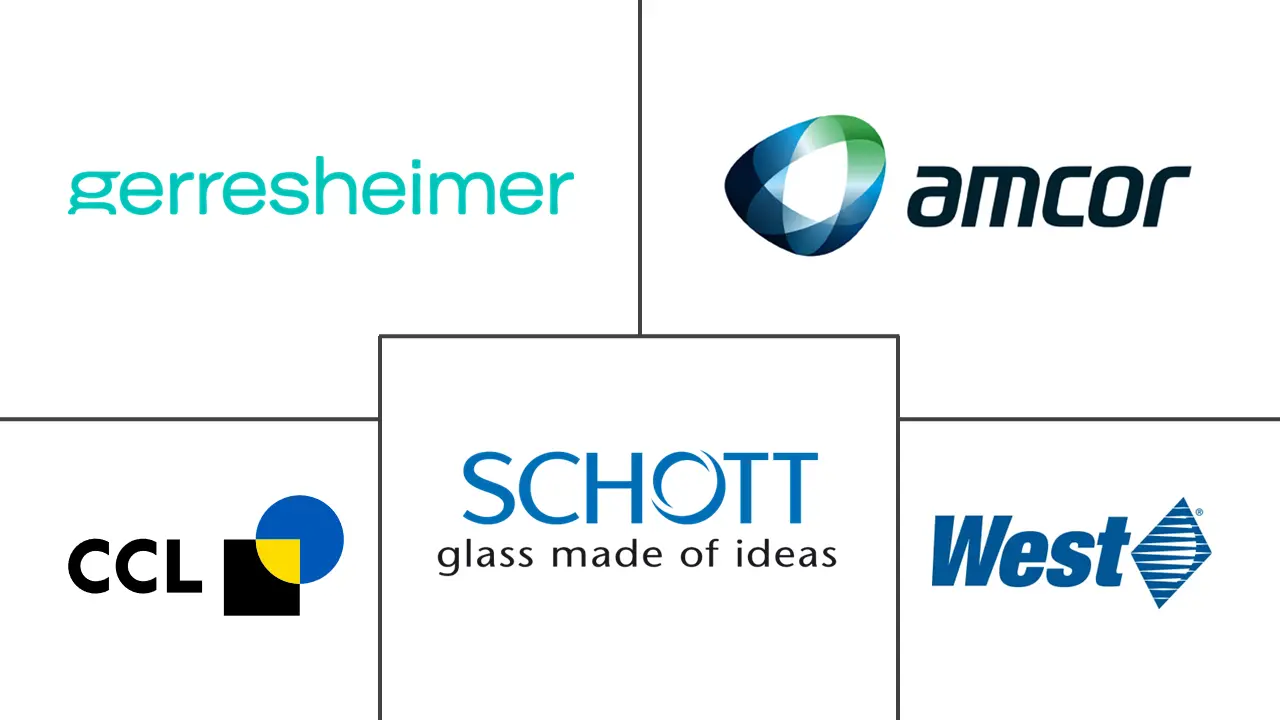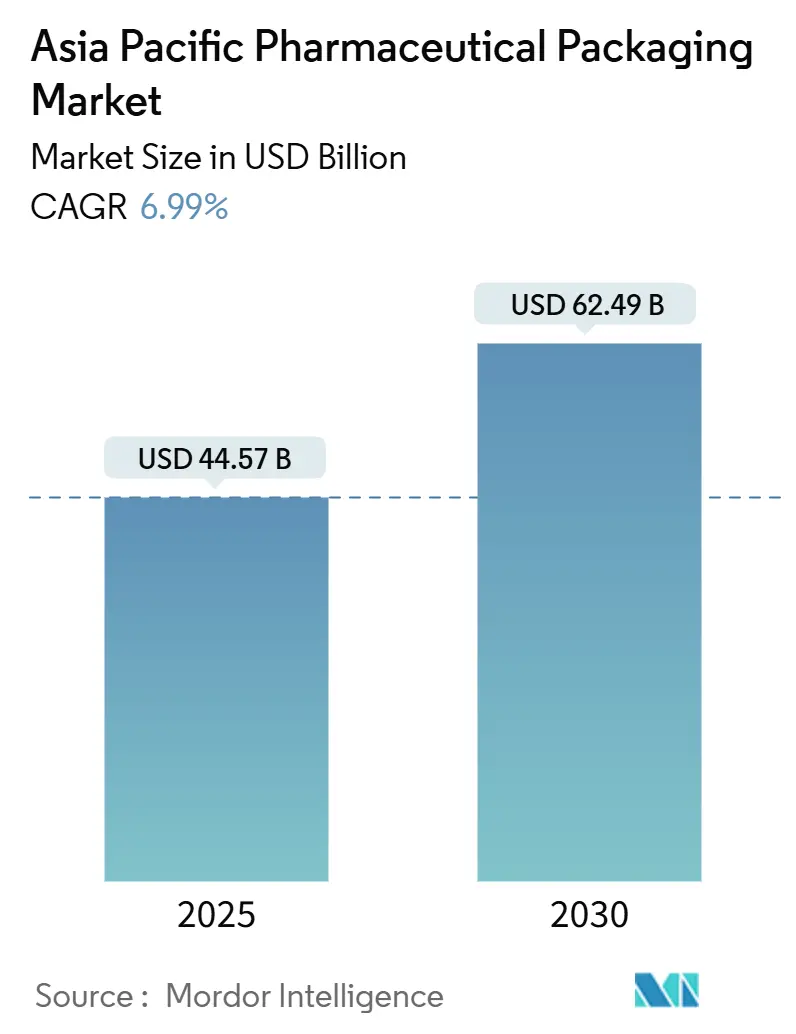
Asia Pacific Pharmaceutical Packaging Market Analysis by Mordor Intelligence
The Asia Pacific pharmaceutical packaging market size reached USD 44.57 billion in 2025 and is projected to advance to USD 62.49 billion by 2030, registering a 6.99% CAGR. This steady climb reflects the region’s transition from a low-cost production base into a global center for high-value biologics, complex fill-finish services, and serialization-ready packaging lines. Demand intensifies as China enforces e-code serialization and India scales its Drug Authentication and Verification Application, pushing every tier of the supply chain toward traceable, tamper-evident formats. Material innovation also quickens: converters move from commodity plastics toward cyclic olefins and bioplastics that withstand deep-cold logistics for cell-and-gene therapies. In parallel, pharmaceutical brand owners favor single-dose formats and integrated digital identifiers, locking the Asia Pacific pharmaceutical packaging market into a multi-year investment cycle focused on sustainability and compliance.
Key Report Takeaways
- By material, plastic held 47.21% of Asia Pacific pharmaceutical packaging market share in 2024. The Other Advanced Materials segment is projected to grow at a CAGR of 8.56% CAGR between 2025-2030.
- By type, blister packs led with 29.53% revenue share in 2024, whereas stick packs are projected to rise at a 9.43% CAGR to 2030.
- By drug-delivery mode, pulmonary packaging is projected to achieve a 10.12% CAGR over the forecast period whereas injectable segment led with 57.12% revenue share in 2024.
- By country, India is poised for the fastest growth, with an 8.23% CAGR through 2030. China held 42.13% of Asia Pacific pharmaceutical packaging market share in 2024.
Asia Pacific Pharmaceutical Packaging Market Trends and Insights
Drivers Impact Analysis
| Driver | (~) % Impact on CAGR Forecast | Geographic Relevance | Impact Timeline |
|---|---|---|---|
| Rising biologics pipeline demanding high-integrity primary packaging | +1.8% | China, India, Japan, South Korea | Medium term (2-4 years) |
| Accelerated fill-finish outsourcing to Asia driving contract packaging volumes | +1.5% | India, China, Singapore | Short term (≤ 2 years) |
| Government bulk-procurement schemes favouring cost-efficient blister formats | +1.2% | India, China | Medium term (2-4 years) |
| Serialization regulations boosting track-and-trace packaging | +1.0% | China, India | Short term (≤ 2 years) |
| Surge in low-dose, high-potency OSD drugs spurring adoption of high-barrier PTP foils | +0.8% | Japan, South Korea, Australia | Long term (≥ 4 years) |
| Growth of temperature-sensitive cell-and-gene therapies creating demand for cryo-compatible vials | +0.6% | Japan, Australia, Singapore | Long term (≥ 4 years) |
| Source: Mordor Intelligence | |||
Rising Biologics Pipeline Demanding High-Integrity Primary Packaging
Biologics represented 34% of SCHOTT Pharma’s biopharmaceutical revenue in 2024, lifting total sales to USD 1.05 billion and signaling a structural pivot toward pre-sterilized borosilicate formats that minimize contamination risk.[1]SCHOTT Pharma, “MEDIA RELEASE | SCHOTT Pharma, GerresheimerStevanato Group echoed this trend, generating USD 1.21 billion in fiscal 2024 with 38% of revenue from ready-to-use vials and cartridges. [2]Stevanato Group announce strategic industry ‘Alliance for RTU’,’’ schott-pharma.com The two firms, together with Gerresheimer, formed the Alliance for RTU in September 2024 to standardize ready-to-use container formats across the Asia Pacific pharmaceutical packaging market. Contract manufacturers now specify depyrogenated vials and pre-assembled closures at bid stage, compressing validation timelines for vaccine and monoclonal antibody launches. As biologics pipelines mature, high-value container demand expands beyond top-tier sites, encouraging regional glass makers to retrofit furnaces for tighter dimensional tolerances and visible-particle-free output.
Accelerated Fill-Finish Outsourcing to Asia Driving Contract Packaging Volumes
Lotus Pharmaceutical’s FDA-, EMA- and PMDA-certified network earned a record first-half 2025 revenue, reinforcing India’s ability to absorb complex fill-finish work relocated from Western plants. Singapore and South Korea compete on biologics expertise, while cost-efficient sterilization suites in China shorten lead times for seasonal vaccine production. The Asia Pacific pharmaceutical packaging market consequently records higher throughput for nested syringes, dual-chamber cartridges, and serialized secondary cartons. Technology transfer contracts increasingly bundle packaging qualification with drug-product manufacture, elevating local converters into solution partners rather than commodity suppliers. This momentum accelerates adoption of ISO -compliant clean-room infrastructure and creates a ripple effect on labelling, inspection, and aggregation services.
Government Bulk-Procurement Schemes Favouring Cost-Efficient Blister Formats
India’s centralized tenders reward bidders that can supply aluminum-plastic blister cards meeting moisture ingress specifications at the lowest landed cost. Similar efforts under China’s volume-based procurement reinforce the dominance of blister tooling on local production lines. Aluminum foil demand therefore stays resilient even as sustainable alternatives gain attention. Manufacturers retrofit stamping presses to cut forming-cycle times, protecting margins in a price-sensitive environment. For patients, portability and unit-dose clarity improve adherence, aligning public-health goals with procurement policies and ensuring blisters retain the largest slice of the Asia Pacific pharmaceutical packaging market.
Serialization Regulations Boosting Track-and-Trace Packaging
China’s e-code requirement and India’s DAVA mandate compel every exporter to generate unique identifiers at pack level, integrate tamper evidence, and maintain data exchange with central portals. Converters add high-speed digital printers and vision systems capable of verifying 600 cartons per minute without compromising code readability. Early adopters share implementation road maps at regional forums, accelerating diffusion across mid-tier firms. Technology suppliers bundle software, line-hardware, and cloud reporting in service contracts, creating a fresh revenue layer on top of material sales. Compliance investment deepens customer stickiness and raises the entry barrier for non-compliant players, consolidating market share among serialization-ready converters.
Restraints Impact Analysis
| Restraint | % Impact on CAGR Forecast | Geographic Relevance | Impact Timeline |
|---|---|---|---|
| Volatile resin and alumina prices squeezing converter margins | -1.2% | Global, particularly China and India | Short term (≤ 2 years) |
| Stringent PVC phase-out policies in Japan and South Korea | -0.8% | Japan, South Korea | Medium term (2-4 years) |
| Port congestion and cold-chain bottlenecks slowing export shipments | -0.6% | China, India, Southeast Asia | Short term (≤ 2 years) |
| Limited regional supply of pharma-grade borosilicate tubing | -0.4% | Asia Pacific, excluding Japan | Medium term (2-4 years) |
| Source: Mordor Intelligence | |||
Volatile Resin and Alumina Prices Squeezing Converter Margins
Winpak’s 2024 earnings call revealed a 9-13% quarter-over-quarter drop in nylon and aluminum foil prices after earlier spikes, underscoring the commodity whiplash confronting converters.[3]Winpak Ltd., “Winpak Reports 2024 Fourth Quarter Results,” newswire.ca Packaging producers devote treasury resources to hedging strategies and flexible pricing clauses, yet smaller firms lack the credit lines to buffer sudden surges. Inventory runs leaner, raising the risk of line stoppages when suppliers ration allocations. Uneven cost absorption places integrated multinationals at an advantage, tilting competitive balance within the Asia Pacific pharmaceutical packaging market toward scale players that negotiate annual raw-material contracts.
Stringent PVC Phase-Out Policies in Japan and South Korea
Japan’s 2025 update to its positive list system tightens exposure limits on phthalate plasticizers, hastening substitution away from PVC in primary healthcare packs. South Korea’s chemical-restriction rule set follows a similar path, obligating stability re-testing when materials change. Converters expedite qualification of PET-based blister lidding and cyclo-olefin films, yet new tooling and validation raise capital costs. Brand owners balance regulatory compliance against patient-unit pricing, sometimes extending sunset timelines for legacy SKUs. The transition creates a temporary lull in capacity utilization for PVC sheet extruders and injects complexity into multi-country supply chains that must segregate non-compliant inventory.
Segment Analysis
By Material: Advanced Materials Expand Performance Boundaries
Plastic maintained a commanding 47.21% share of the Asia Pacific pharmaceutical packaging market in 2024 thanks to established extrusion and injection-molding capacity close to major drug-manufacturing clusters. Yet the segment’s mid-single-digit growth contrasts with the 8.56% CAGR logged by advanced materials, underscoring a pivot toward cyclic olefins, bio-based polymers, and specialty glass that better withstand cryogenic storage and high-potency drugs. The Asia Pacific pharmaceutical packaging market size attributable to cyclic-olefin copolymers is projected to climb in double digits as biologics pipelines deepen and Annex 1 clean-room standards tighten.
Mitsui Chemicals’ APEL™ demonstrates how cyclic-olefin innovation satisfies moisture-barrier demands while remaining compatible with gamma sterilization, enabling wider adoption in pre-filled syringe barrels. Glass producers also renovate furnaces for Type I borosilicate, aiming to capture injectable fill-finish growth without the delamination risks of legacy vials. On the sustainability front, film converters experiment with PLA-nanocellulose blends that promise compostability yet meet extractables limits required by pharmacopeias. Regional regulators support this shift by issuing guidance prioritizing recyclability and carbon-footprint disclosure, embedding environmental metrics into material-selection checklists.
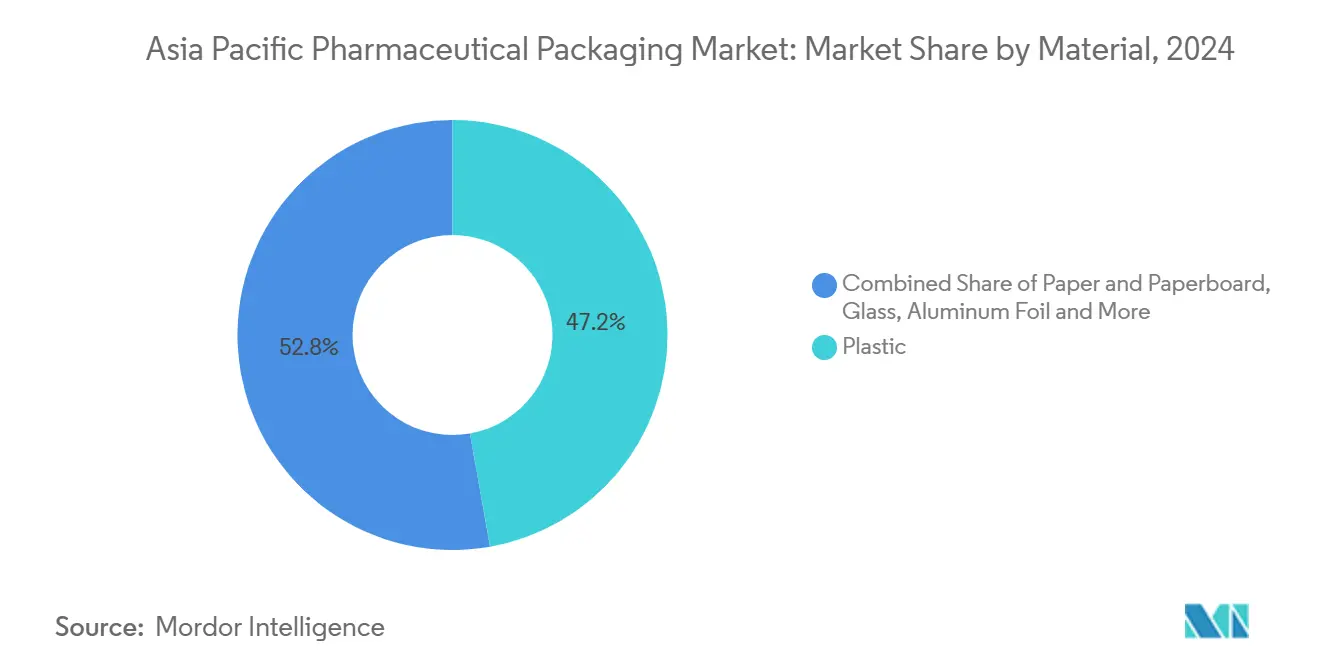
Note: Segment shares of all individual segments available upon report purchase
By Type: Stick Packs Meet the Single-Dose Imperative
Blister packs delivered 29.53% of 2024 revenues, proving indispensable in centralized procurement and over-the-counter channels. However, stick packs are forecast to outrun every other format with a 9.43% CAGR as brand owners target chronic disease therapies requiring precise titration and on-the-go convenience. Stick-pack machines use up to 40% less film than four-side-sealed sachets, granting pharmaceutical marketers both cost and sustainability dividends. The Asia Pacific pharmaceutical packaging market size for stick packs, though relatively small today, is set to exceed USD 3 billion by 2030 as vitamins, probiotics, and pediatric formulations migrate into this delivery style.
Concurrently, vials, syringes, and cartridges expand through biologics demand, driving downstream needs for tamper-evident caps and sterile closures. IV-fluid pouches remain a hospital staple, yet competitive pressure from blow-fill-seal bottles spurs differentiation on puncture resistance and clear-film readability. Digital printing gains traction on all secondary packs, enabling micro-batch personalization for clinical trials and niche therapies while preserving supply-chain traceability.
By Drug Delivery Mode: Pulmonary Leads Next-Wave Growth
Injectable formats dominated the 2024 revenue base with 57.12% share, mirroring the region's surge in monoclonal antibody and vaccine output. Still, pulmonary packaging stands out with a 10.12% CAGR, reflecting the commercial rollout of dry-powder inhalers that couple engineered particles with precision-dose devices. Academic studies indicate that optimized particle aerodynamics improve lung deposition, prompting device makers to co-develop moisture-barrier primary packaging that preserves powder flow. The Asia Pacific pharmaceutical packaging market share for pulmonary formats remains modest today, but rising asthma prevalence and biotech interest in inhaled biologics anchor a robust runway.
Oral-solid dosage maintains relevance via tablets and capsules, particularly in the over-the-counter and export segments. Topical and transdermal packs benefit from laminate films that enable unit-of-use secretion control, supporting dermatology innovations across Japan and Australia. Niche modes such as ophthalmic squeeze tubes and implantable reservoirs broaden the application spectrum, requiring ISO-class moldings and tight particulate control that lift technical barriers to entry for new suppliers.
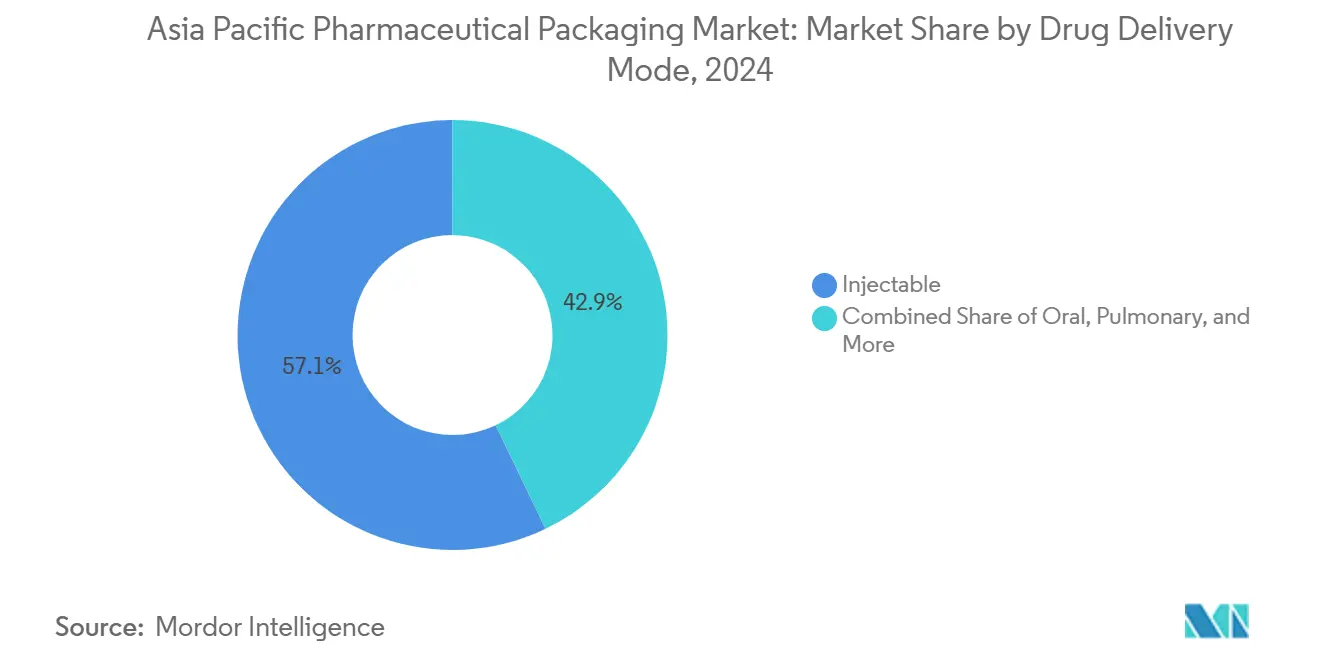
Note: Segment shares of all individual segments available upon report purchase
Geography Analysis
China anchors the Asia Pacific pharmaceutical packaging market with a 42.13% stake in 2024, drawing strength from vertically integrated supply chains that range from raw glass tubing to automated cartoning. SGD Pharma’s furnace retrofit in Zhanjiang underscores ongoing capacity upgrades aimed at high-value injectable containers. Coupled with state-mandated e-code serialization, these investments align domestic production with global regulatory norms and keep foreign buyers confident in China-sourced packs. Government incentives for biologics research further drive local demand for RTU vials, nested syringes, and cryo-stable bags.
India, forecast to log the fastest 8.23% CAGR, leverages abundant technical talent and cost competitiveness. PAG’s USD 200 million majority stake in Pravesha Industries reflects foreign investor appetite for Indian converters that already export 95% of output to highly regulated markets. The country’s DAVA serialization rollout compels even small-volume producers to modernize packaging lines, expanding the addressable base for coding equipment, tamper-evident labels, and cloud-hosted track-and-trace services.
Japan and South Korea stand out for stringent material standards and early PVC withdrawal, turning these nations into proving grounds for cyclic-olefin sheets and PET-based blister cards. Their advanced biologics pipelines sustain demand for glass cartridges and high-barrier lidding, encouraging overseas suppliers to localize technical service centers. Australia and the wider Rest-of-Asia cluster contribute steady gains, fueled by niche manufacturing such as plasma-derived therapies and import substitution policies that foster domestic packaging capacity.
Competitive Landscape
The Asia Pacific pharmaceutical packaging market features a mix of global incumbents and agile regional players, yielding a moderate concentration profile. SCHOTT Pharma attributes 60% of 2025 revenues to high-value solutions following capacity expansions in Japan and India. Amcor’s merger with Berry Global, closed in April 2025, seeks USD 650 million in synergy savings and broadens film-lamination competences across China, Thailand, and Malaysia. Such consolidation allows multinationals to leverage purchasing power for resins and alumina, buffering raw-material volatility that challenges smaller rivals.
Regional specialists retain competitive footing by offering low-minimum-order runs, rapid artwork changes, and competitive lead times, particularly in secondary packaging. They also form alliances with equipment suppliers to offer turnkey serialization upgrades, enhancing value propositions beyond mere material supply. In niche segments, technology partnerships flourish: BD collaborates with Ypsomed on self-injection systems for viscous biologics, marrying glass barrel expertise with auto-injector ergonomics.
Supply-chain resilience shapes strategic direction as converters add capacity closer to demand hubs; Colorcon’s 200,000-square-foot coating facility in Malaysia exemplifies this decentralization and underpins shorter shipping corridors to India and Australia. High-barrier film makers and glass producers continue to integrate vertically into closure systems and labelling services, increasing wallet share per packaged dose. Overall, rivalry centers on speed-to-compliance for serialization, material sustainability, and total cost of ownership for biopharma customers.
Asia Pacific Pharmaceutical Packaging Industry Leaders
-
Amcor plc
-
Gerresheimer AG
-
Schott AG
-
West Pharmaceutical Services Inc
-
CCL Industries Inc
- *Disclaimer: Major Players sorted in no particular order
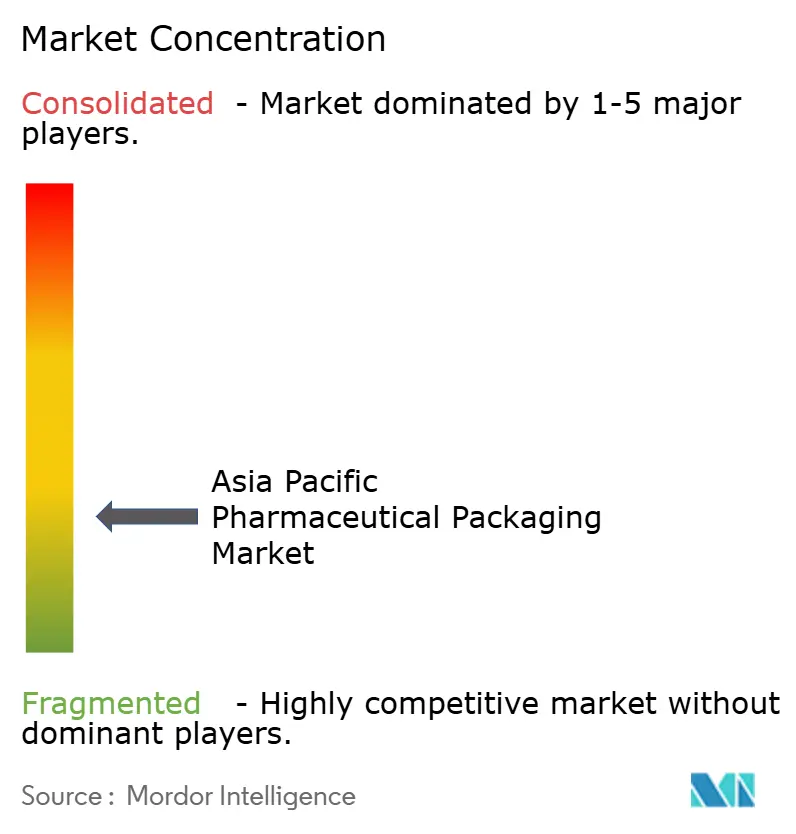
Recent Industry Developments
- September 2025: TOPPAN Corporation showcased GL BARRIER high-performance film and advanced serialization at JACLaS EXPO 2025, promoting aluminum replacement and layer reduction.
- August 2025: SCHOTT Pharma posted preliminary Q3 2025 revenues of USD 282 million, with high-value solutions accounting for 60% of sales.
- July 2025: Colorcon inaugurated a 200,000-square-foot film-coating plant in Malaysia to support fast-growing demand across Asia.
- May 2025: WinHealth Pharma and Merz Therapeutics expanded their Greater China alliance, raising product coverage from two to five brands.
- May 2025: Stevanato Group reported Q1 2025 revenue of USD 282 million and continued investments in injectable-container capacity in the United States and Italy.
Asia Pacific Pharmaceutical Packaging Market Report Scope
Pharmaceutical packaging is the packaging process for pharmaceutical products. The packaging material can be made of several raw materials, such as glass, plastic resins, and metal, and its application is based on the reactivity of the pharmaceutical products to be packaged. The Asia-Pacific pharmaceutical packaging market is segmented by material (plastic, paper and paper board, glass, and aluminum foil), type (ampoules, blister packs, plastic bottles, syringes, vials, and IV fluids), drug delivery mode (oral drug packaging, injectable drug packaging, and pulmonary drug packaging), and country (India, Japan, China, Australia, and Rest of Asia-Pacific). The market sizes and forecasts are provided in terms of value (USD) for all the above segments.
| Plastic |
| Paper and Paperboard |
| Glass |
| Aluminum Foil |
| Other Materials (Bioplastics, Cyclic Olefins) |
| Ampoules |
| Blister Packs |
| Plastic Bottles |
| Syringes |
| Vials |
| IV Fluids |
| Stick Packs |
| Pouches and Sachets |
| Caps and Closures |
| Oral |
| Injectable |
| Pulmonary |
| Topical and Transdermal |
| Other Modes |
| China |
| India |
| Japan |
| South Korea |
| Australia |
| Rest of Asia Pacific |
| By Material | Plastic |
| Paper and Paperboard | |
| Glass | |
| Aluminum Foil | |
| Other Materials (Bioplastics, Cyclic Olefins) | |
| By Type | Ampoules |
| Blister Packs | |
| Plastic Bottles | |
| Syringes | |
| Vials | |
| IV Fluids | |
| Stick Packs | |
| Pouches and Sachets | |
| Caps and Closures | |
| By Drug Delivery Mode | Oral |
| Injectable | |
| Pulmonary | |
| Topical and Transdermal | |
| Other Modes | |
| By Country | China |
| India | |
| Japan | |
| South Korea | |
| Australia | |
| Rest of Asia Pacific |
Key Questions Answered in the Report
What is the current value of the Asia Pacific pharmaceutical packaging market?
It is valued at USD 44.57 billion in 2025.
How fast is the market expected to grow through 2030?
The forecast CAGR is 6.99%, lifting value to USD 62.49 billion.
Which packaging type is expanding the quickest?
Stick packs are projected to advance at a 9.43% CAGR, the fastest among all types.
Which country is forecast to grow the most rapidly?
India is set for the highest 8.23% CAGR between 2025 and 2030.
What material segment shows the strongest growth outlook?
Advanced materials such as bioplastics and cyclic olefins are projected to grow at an 8.56% CAGR.
Why are serialization regulations important?
They compel unique identifiers and tamper evidence on every pack, enhancing supply-chain security and driving investment in coding technologies.
Page last updated on:
